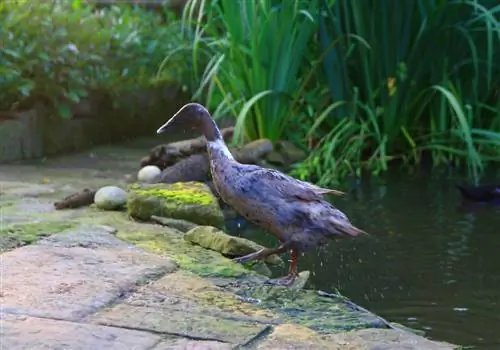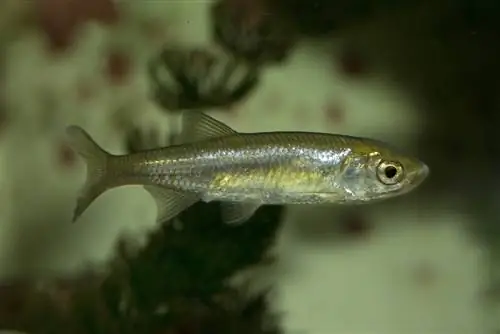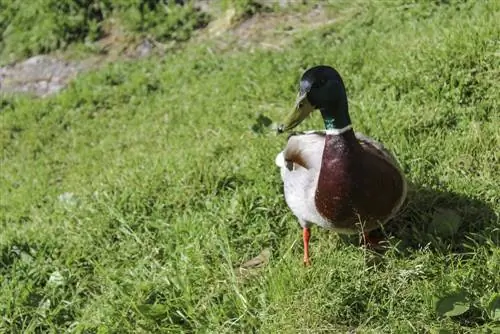- Author admin [email protected].
- Public 2023-12-16 16:46.
- Last modified 2025-06-01 06:02.
With their heads held high, running ducks waddle through the garden or splash happily in the pond. For most of the day, the lively snail hunters scour beds and lawns with their beaks in search of juicy prey. Have you also succumbed to the graceful charm of the cute water birds and are considering settling them on your property? This guide will familiarize you with important parameters related to buying and keeping ducks.
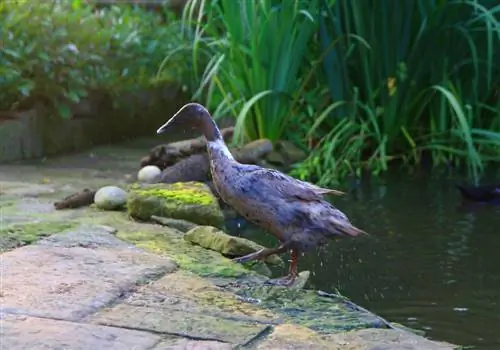
Buy running ducks - breeders, prices, buying tips
Running ducks are friendly, needy and lovable. Please give the purchase as much attention as you would the purchase of a dog, cat or horse. The funny water birds will bring you and your family a lot of joy if you buy he althy, happy animals from an experienced breeder. Be sure to ignore questionable offers on free classified ad portals. Meaningful sources for contact details for trustworthy providers include, for example, the Special Association of Runner Duck Breeders in Germany (laufenten-sv.de) or the Association of German Breeded Poultry Breeders e. V. (bdrg.de). The following prices are charged on average for purebred, ringed ducks from competent breeding:
- Drake (annual): 15 EUR
- Duck (annual): 20 EUR
- Chick: 5 EUR
The best time to buy runner ducks is in late summer, ideally in August. From September onwards, the pairs of ducks form for the next year and then stay together. In this phase, the waterfowl have molted and young animals are fully developed. Furthermore, the courtship instinct is dormant so that no violent conflicts disturb the acclimatization in the garden.
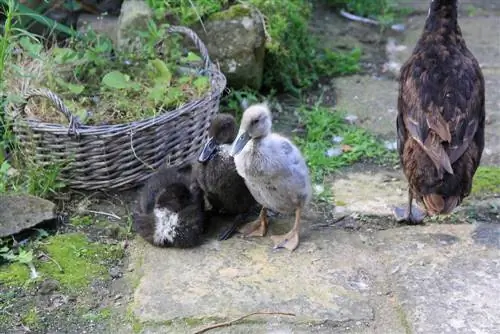
Chicks are particularly cheap and cute
Observe important purchasing criteria
Buy runner ducks only as a pair or small group, for example 1 drake and 3 to 4 ducks (females always in the majority). Take a critical look at the breeding area, because good keeping conditions are fundamental for he althy animals. Do not buy chicks that are separated from their mother. Ask the exact age of the ducks. Artificially bred chicks should be at least 6 to 8 weeks old. Adult runner ducks are best suited as new family members at 1 year of age. Obtain information about the last deworming and note what the animals have been fed so far. Ideally, you should buy a small supply of food from the breeder for the first week of your feathered offspring in their new home.
Please take a softly padded transport container that is not too large and will guarantee your new family members a good supply of air. For a longer return journey with running ducks, please plan breaks to offer the animals water. Make an appointment with the breeder so that he has time to make a careful selection and answer important questions.
Excursus
Rent ducks - no-go for animal lovers
It sounds too good to be true. Rent ducks, chase them through the garden and the voracious snail plague is history. However, what is overlooked is that these bright water birds have a sensitive nature and require a lot of attention and care. The basic requirements for species-appropriate husbandry include, among other things, a marten-proof fenced property with a pond and stable. Daily feeding is essential. Furthermore, runner ducks not only eat snails, but also do not disdain beneficial insects. A short-term use of the chattering snail hunters upsets the ecological balance in the enclosure. If rental ducks leave the property, the insatiable slimes are back on site within a week.
Running ducks - breed characteristics at a glance
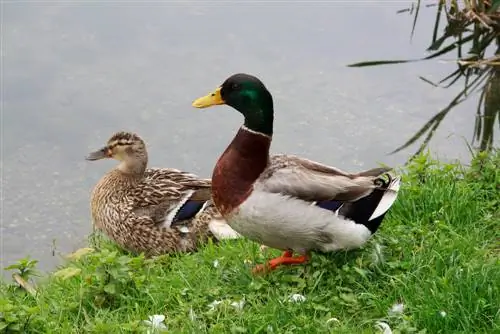
Running ducks are descended from mallards
Running ducks are descended from the mallard duck (Anas platyrhynchos). In the middle of the 19th century, the first specimens from Southeast Asia found their way to Europe, where the slim, elegant animals initially populated the gardens of England. From the 20th century onwards, ducks with their upright gait conquered continental European parks and green spaces. Today the general term penguin duck includes a total of three breeds that are useful as runner ducks in the garden. The following table lists the essential breed characteristics:
| Breed | other name | Size (head to tip of tail) | Weight | Coloring plain dress | Laying performance per year |
|---|---|---|---|---|---|
| Indian Runner Ducks | Bottle Duck | 50 to 76 cm | 2, 5 to 3 kg | 10 color strokes | 150 to 200 eggs |
| Japanese Runner Ducks | Japanese Duck | 70 to 75 cm | 3, 5 to 4 kg | light brown-gray speckled | 80 to 90 eggs |
| Chinese Runner Ducks | Peking Duck | 65 to 75 cm | 3 to 4.5 kg | white | 60 to 80 eggs |
What all duck breeds have in common is a tightly upright, almost vertical posture. The proportions of purebred ducks consist of one third neck and two thirds body. The plumage lies tightly on the cylindrical body. The classification as a penguin type is primarily based on these central racial characteristics. This is easy to understand, because the association with flightless seabirds is closer than the comparison with domestic ducks.
Indian runner ducks - the most beautiful colors
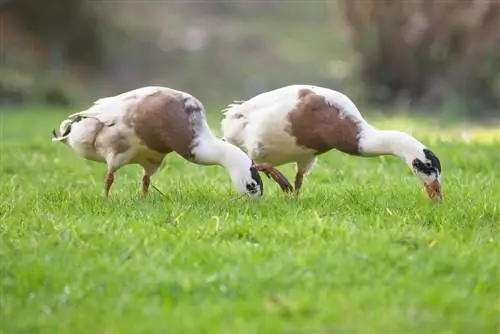
Indian runner ducks appear with different colors
As the table above demonstrates, various breeds of ducks are characterized by upright walking under the collective term penguin duck. If runner ducks are found in gardens and parks, they are usually Indian runner ducks. The penguin duck breed is not only more elegant, lively and nimble than Chinese and Japanese runner ducks. With a total of 10 recognized colors, Indian runner ducks are a picturesque feast for the eyes. We present some of the most beautiful plumage colors in more detail below:
Trout colored
The drake impresses with a green neck and head, decorated with an open neck ring. A burgundy breast and silver-grey wings catch the eye. The dark back is lined with silver gray on the rump. Light pearl gray marks the legs and flanks. The tail boasts a dark curl of drake, an important clue for sex determination. Beak color is willow green. The duck is characterized by a light brown base color with a silver factor. Sharply defined spots can be seen on the back, belly and rump. Coverts of wings and back are lined with brown. An orange beak is unmistakable.
Silver-wild colored
The drake comes with a silvery-creamy white base color. The shoulders, neck, chest and base of the neck are lined with silver and white. The belly and flank plumage are also silvery white. The rump stands out brown-black, of course with dark drake curls as a distinguishing feature from the Indian running duck ladies. Beak color is willow green to gray. The female beauties have chosen a yellowish-white base color with a brown-stitched back, neck, base of the neck and upper chest. A blue mirror peeks out on the wings. Beak color is gray-green.
Are you toying with subtle, monochrome Indian runner ducks? Then the popular breed has pure white specimens with a lemon-yellow beak. The thoroughbred racers come in pure black with an emerald green shimmer and a matching dark olive green beak.
Tip
A herb spiral protects basil, sage and parsley from the large slippers of runner ducks. Grow young vegetables, tempting lettuce and tread-sensitive flowers in raised beds, as direct contact with the eager snail hunters doesn't end well for most small plants.
Interesting facts about runner ducks - question-answer quiz
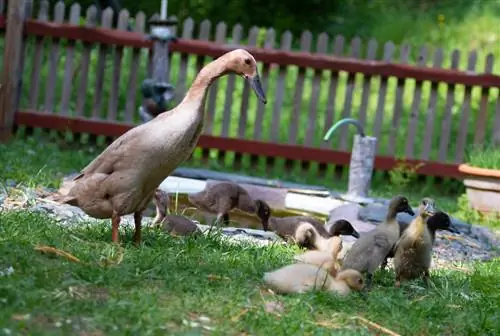
Although runner ducks can run well, they need a pond
Even the first look at pictures and videos arouses curiosity for further information about the cute runner ducks. Reducing these lively fellows to their function as natural snail control does not do justice to their lovable, peace-loving disposition. Please familiarize yourself with the important characteristics of runner ducks before considering keeping them in the garden. We invite you to an introductory quiz that will give you useful information quickly as a question and answer game:
| Question | Answer |
|---|---|
| Can ducks fly? | No |
| Can ducks swim? | Yes, a swimming pond is mandatory |
| Are runner ducks solitary creatures? | No, but sociable herd animals |
| How old do runner ducks get? | Life expectancy: 12-15 years |
| What do runner ducks eat? | Chicken feed, unseasoned leftovers, fresh greens, snails, beetles |
| How long do runner ducks breed? | Breeding period: 20-30 days |
| How much do hatching eggs weigh? | Minimum weight: 55-65 grams |
| How long do chicks take to hatch? | Hatch duration: up to 24 hours |
| Can you raise ducklings yourself? | Yes, but it is very time-consuming |
| How can you recognize a drake? | Drake curl on tail, quiet voice |
Gender determination is a frequent headache for Laufi friends. The drake's curl in the form of a curved feather at the end of the tail only reveals the gender at an advanced age. In order to distinguish between drakes and ducks among young animals, a close look at the cloaca (common body outlet for the digestive and sexual organs) should provide information. Well-founded statements can primarily be made by veterinarians, biologists and breeders. As a layperson, we recommend paying attention to the noise level. Ducks make loud chattering noises, whereas drakes only hear a quiet räb-räb.
Keeping ducks in a species-appropriate manner - This is how it works

The perfect, species-appropriate keeping of ducks rests on four pillars: fenced property, pond or watering holes, lockable stable and pesticide-free garden. All four cornerstones for a carefree life together with the lovable companions in feathers are examined in more detail below:
Property - tips on size and fence
Running ducks are good on foot. What waterfowl lack in flight ability, they make up for in nimble legs. An allotment garden in towel format is far too small for a mini cast of two running ducks. Recognized Laufi experts agree that each duck needs an enclosure of around 500 square meters. This means a minimum size of 1,000 square meters if you keep a pair of ducks in the garden. Your feathered snail hunters will greatly appreciate a varied planting of grasses, bushes and trees that offer great hiding places.
A fence is mandatory if you want to share your garden life with running ducks for a long time. The fencing aims to keep the ducks in and enemies out. In normal, quiet everyday life, running ducks become visibly afraid of heights when they are at 30 centimeters of ground clearance. Panic causes the birds to forget their fear of flying and flutter to a height of over 1 meter. Hungry martens, foxes and raccoons lurk outside to feast on the ducks, their chicks or eggs. The best protection for the running duck enclosure is a dense fence 1.80 to 2 meters high. Keeping ducks without a fence is not recommended.
Duck pond - ideas for small and large water worlds
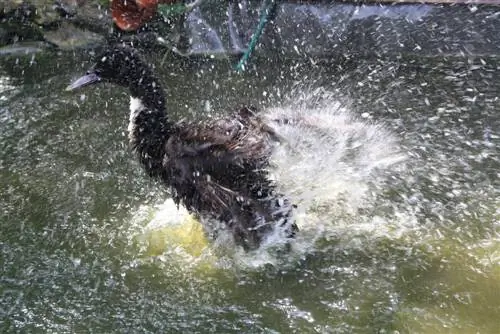
Running ducks love water
Only a pond turns the garden into a duck paradise. The water birds love to swim and splash around. At the same time, a pond provides vital drinking water to get rid of slimy snails and dry grain food. Runner ducks are not picky. If necessary, it can also be a children's paddling pool or a large tub. All varieties of water in the garden are welcome for bottle ducks.
A solution that is as practical as it is decorative for the ideal water world for your ducks is a stream with a filter system. Since the water is constantly moving, it stays clean longer than in a stagnant pond or biotope. However, you can save yourself the bank planting, because stream bunks, swamp forget-me-nots and other plants are mercilessly trampled down or simply plastered over.
Stall - Notes on size and furnishings
A stable as marten-proof night quarters is a must if you keep ducks in the garden. The recommended fence alone is not enough to keep martens and foxes out in the dark. Especially in spring, the predators are looking for food for their offspring at night and early in the morning and are rigorous in their work. A duck house should be a few square meters in size. For a couple, the size of a doghouse for a German Shepherd or St. Bernard is the standard. Dry bedding, ideally straw, serves as interior decoration. The approximately 50 centimeter high door should definitely be lockable, because running ducks don't like to stay in the stable voluntarily.
Pesticide-free garden - just no slug pellets
Snail pellets reliably hunt down any running duck. With a poisoned slug, the ducks also ingest the slug pellets, which kill them within a few minutes. It's easy to avoid fighting snails with slug pellets because your running ducks master this task with flying colors. Furthermore, chemical fungicides, herbicides and other pesticides are taboo in the garden when there are bottle ducks in it. Not only do your snail hunters in their feathers benefit from a poison-free natural garden, but the entire ecological balance and the he alth of your family.
Care Tips for Runner Ducks
Species-appropriate care completes the professional keeping of ducks in the garden. Additional food brings variety to the summer menu, which mainly consists of snails. When snails become rare in winter and little greenery grows, daily supplementary feeding becomes the focus. Water plays a central role in keeping and caring for happy ducks all year round. We have listed important care tips for you below:
- Food: chicken feed, oatmeal, unseasoned leftovers, lettuce leaves, shrimp, rice (no avocados)
- Drinking water: set up water points in several places in the garden and refresh them daily
- Digestive aids: small stones or river sand, especially important in winter when the ground is frozen
- Preventing diseases: deworm twice a year (proven dewormer Concurat)
- Winter care: Insulate and heat the stable for running ducks with straw in winter from - 10 degrees Celsius outside temperature
When running ducks are raising chicks, additional precautions must be taken. During breeding, a duck wants to be left alone. Only check the nest when the expectant mother is briefly out looking for food, defecating or grooming her feathers. After the end of the approximately 28-day breeding season, chicks and their hens must live separately from the drake. A running duck drake sees chicks as competition and often attacks its own offspring. A good protection for the kindergarten enclosure is a mobile chicken fence.
Chick food - tips for the perfect menu
The food of adult ducks is too coarse for their offspring. On the first day of their life, chicks are supplied with nutrients through the yolk sac. From the second day onwards, special chick food from specialist retailers is served on the table. For a change, there are mashed bananas or canned peas and carrots.
Starting with the second week of life, delicious supplements to the chick grain as basic food are very popular with the offspring. A mixture of wheat bran, corn flour, oat flakes and crushed nettles with dandelion creates enthusiasm. The ingredients are mixed with water to form a porridge, which is given a special boost twice a week with a raw chicken egg. At the age of 6 weeks, ducklings like to eat poultry grains with crushed oats. The little ones then get fresh green food and juicy snails from the garden themselves.
Eating duck eggs - a delicacy for connoisseurs
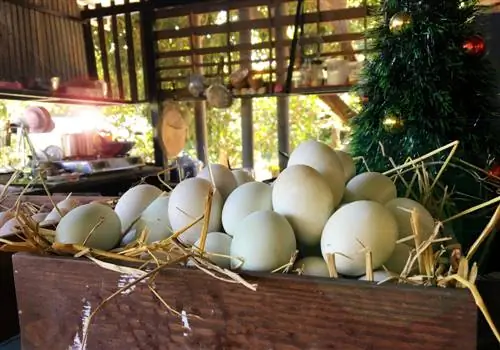
Running ducks lay lots of eggs
Ladies running ducks are true laying miracles. An egg a day is just routine for a hard-working duck. Under the natural conditions of keeping them in the garden, egg production only stops for a while in winter. As soon as spring arrives with longer daylight hours, people eagerly get started again.
Duck eggs are slightly larger compared to chicken eggs and have a thicker and harder shell. Under the white-green shell there is an intense yellow yolk with a delicate taste. Gourmets really appreciate runner duck eggs as delicious scrambled eggs or tasty fried eggs. Thanks to the deep yellow yolks, duck eggs give homemade pancakes and cakes an appetizing color. Of course, chicken eggs still have the edge as breakfast eggs.
Running duck diseases - recognize and act correctly
It is characteristic of ducks and other poultry that diseases can only be recognized in an advanced stage. This is probably a protective function of Mother Nature. Visibly sick ducks are easy prey for robbers and are mercilessly bullied in the flock. Affected runners therefore try very hard not to attract attention. Therefore, observe the animals carefully in order to take action when these signs of illness occur:
- apathetic, listless sitting around
- intense, sick smell in the stable
- conspicuous feces
- severe weight loss
- Difficulty breathing, nasal flow
- Imbalance disorders, symptoms of paralysis
- increased temperature (normal temperature is 41° Celsius)
Self-medication only makes sense if you can clearly diagnose the cause of the disease. To date, more than 20 runner duck diseases are known, some of which manifest themselves with similar symptoms. Instead of administering medication if you suspect a sick duckling, please consult an experienced veterinarian. Contact details of veterinarians experienced in waterfowl can be found, for example, at baseportal.de or vogeldoktor.de.
Frequently asked questions
We plan to keep runner ducks in the garden. Should we buy drakes or female runner ducks?
For the correct answer, please include your environment. If you live close to a residential area, we recommend keeping a pure drake group with at least three animals. Behavioral disorders often occur in same-sex couples. Male running ducks can only make themselves known very quietly, even in panic situations. If your garden is out of earshot of your neighbors, there is nothing to prevent a mixed duck colony. It is important to note that the women are in the majority. Otherwise, there is a risk that overzealous mating attempts by drakes will completely overwhelm the ducks, which can cause tragedy.
How old do runner ducks get?
Under species-appropriate conditions on a property fenced in to protect them from foxes and martens, ducks live between 12 and 15 years old. The Methuselah among the Indian runner ducks reached an impressive age of 20 years.
What do runner ducks eat?
Snails and beetles are at the top of the runner duck menu. Of course, this does not cover the nutrient requirements. Mixed grain feed for chickens has proven to be effective for supplementary feeding in summer and for nutrition in winter when there are few snails. Unseasoned food leftovers cause great enthusiasm in the duck population, such as jacket potatoes, rice, pasta or a few crisp lettuce leaves. Running ducks also enjoy eating a bowl of cat food. A container with water is a must at the feeding place.
Do ducks and cats get along?
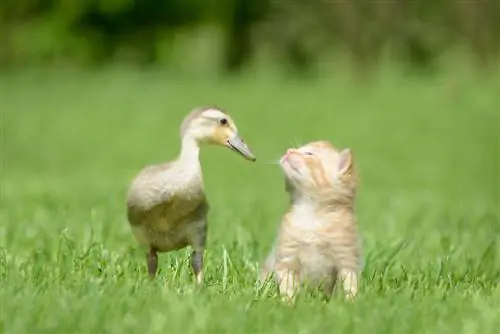
Ducks and cats usually get along well, especially when they grow up together
Cats pose no threat to ducks. In fact, there are numerous amusing stories to be found on the Internet about loving relationships between ducks and cats. Bottle ducks also maintain good neighbors with dogs, as long as they are not trained hunting dogs. Foxes, martens and hawks pose a serious danger to children of all ages.
How many ducks against snails are required for a 5,000 square meter garden?
One pair of ducks is enough to keep an area of 1,000 square meters free of snails. For a large garden of 5,000 square meters, we recommend a colony of 10 to 12 ducks. If loud chatter is acceptable, it can only be ducks. However, you will then be deprived of the enjoyment of fresh duck eggs. If you value peace and quiet in the garden, it should be an all-male group. If you decide to use a mixed force against snails, please make sure that ducks are in the majority.
My ducklings are supposed to raise chicks. How do I determine which eggs are fertilized?
Wait for the duck to leave the nest for a short time. By shining a bright lamp over each egg, you can determine the fertilization rate. After a short incubation period, internal blood veins form in the fertilized duck egg. Take a cardboard lid and cut a hole about 3 x 5 cm into it. Place an egg in it and light it from below. The test must be completed before the mother duck returns to the nest. A family member should stand guard outside to report the duck's arrival in time.
Tip
The keeping of ducks in Germany is linked to various legal regulations. Before you buy runner ducks, please consult the responsible regulatory or veterinary office regarding the reporting requirements. You can also find out from the building authority whether the construction of a stable or enclosure requires approval in your region. It is urgently advisable to have a clarifying discussion with the neighbors, because you will lose out in the legal dispute over noisy running ducks that plunder neighboring gardens.

